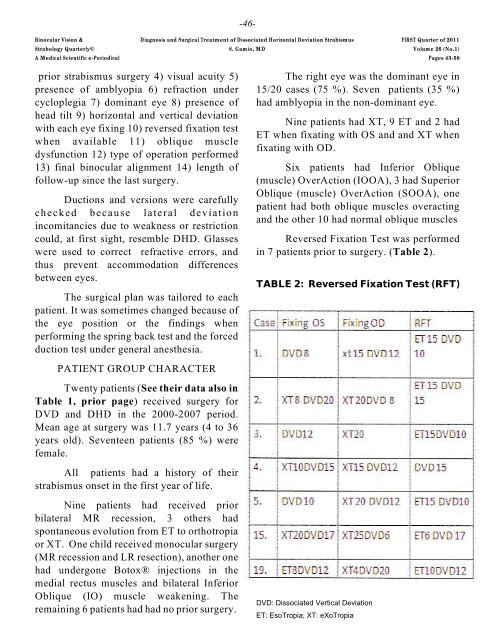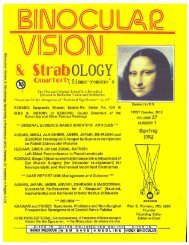Correspondence - ICO Library
Correspondence - ICO Library
Correspondence - ICO Library
You also want an ePaper? Increase the reach of your titles
YUMPU automatically turns print PDFs into web optimized ePapers that Google loves.
-46-<br />
Binocular Vision & Diagnosis and Surgical Treatm ent of Dissociated Horizontal Deviation Strabism us FIRST Quarter of 2011<br />
Strabology Quarterly© S. Gam io, M D Volum e 26 (No.1)<br />
A M edical Scientific e-Periodical Pages 43-50<br />
prior strabismus surgery 4) visual acuity 5)<br />
presence of amblyopia 6) refraction under<br />
cycloplegia 7) dominant eye 8) presence of<br />
head tilt 9) horizontal and vertical deviation<br />
with each eye fixing 10) reversed fixation test<br />
when available 11) oblique muscle<br />
dysfunction 12) type of operation performed<br />
13) final binocular alignment 14) length of<br />
follow-up since the last surgery.<br />
Ductions and versions were carefully<br />
checked because lateral deviation<br />
incomitancies due to weakness or restriction<br />
could, at first sight, resemble DHD. Glasses<br />
were used to correct refractive errors, and<br />
thus prevent accommodation differences<br />
between eyes.<br />
The surgical plan was tailored to each<br />
patient. It was sometimes changed because of<br />
the eye position or the findings when<br />
performing the spring back test and the forced<br />
duction test under general anesthesia.<br />
PATIENT GROUP CHARACTER<br />
Twenty patients (See their data also in<br />
Table 1, prior page) received surgery for<br />
DVD and DHD in the 2000-2007 period.<br />
Mean age at surgery was 11.7 years (4 to 36<br />
years old). Seventeen patients (85 %) were<br />
female.<br />
All patients had a history of their<br />
strabismus onset in the first year of life.<br />
Nine patients had received prior<br />
bilateral MR recession, 3 others had<br />
spontaneous evolution from ET to orthotropia<br />
or XT. One child received monocular surgery<br />
(MR recession and LR resection), another one<br />
had undergone Botox® injections in the<br />
medial rectus muscles and bilateral Inferior<br />
Oblique (IO) muscle weakening. The<br />
remaining 6 patients had had no prior surgery.<br />
The right eye was the dominant eye in<br />
15/20 cases (75 %). Seven patients (35 %)<br />
had amblyopia in the non-dominant eye.<br />
Nine patients had XT, 9 ET and 2 had<br />
ET when fixating with OS and and XT when<br />
fixating with OD.<br />
Six patients had Inferior Oblique<br />
(muscle) OverAction (IOOA), 3 had Superior<br />
Oblique (muscle) OverAction (SOOA), one<br />
patient had both oblique muscles overacting<br />
and the other 10 had normal oblique muscles<br />
Reversed Fixation Test was performed<br />
in 7 patients prior to surgery. (Table 2).<br />
TABLE 2: Reversed Fixation Test (RFT)<br />
DVD: Dissociated Vertical Deviation<br />
ET: EsoTropia; XT: eXoTropia









